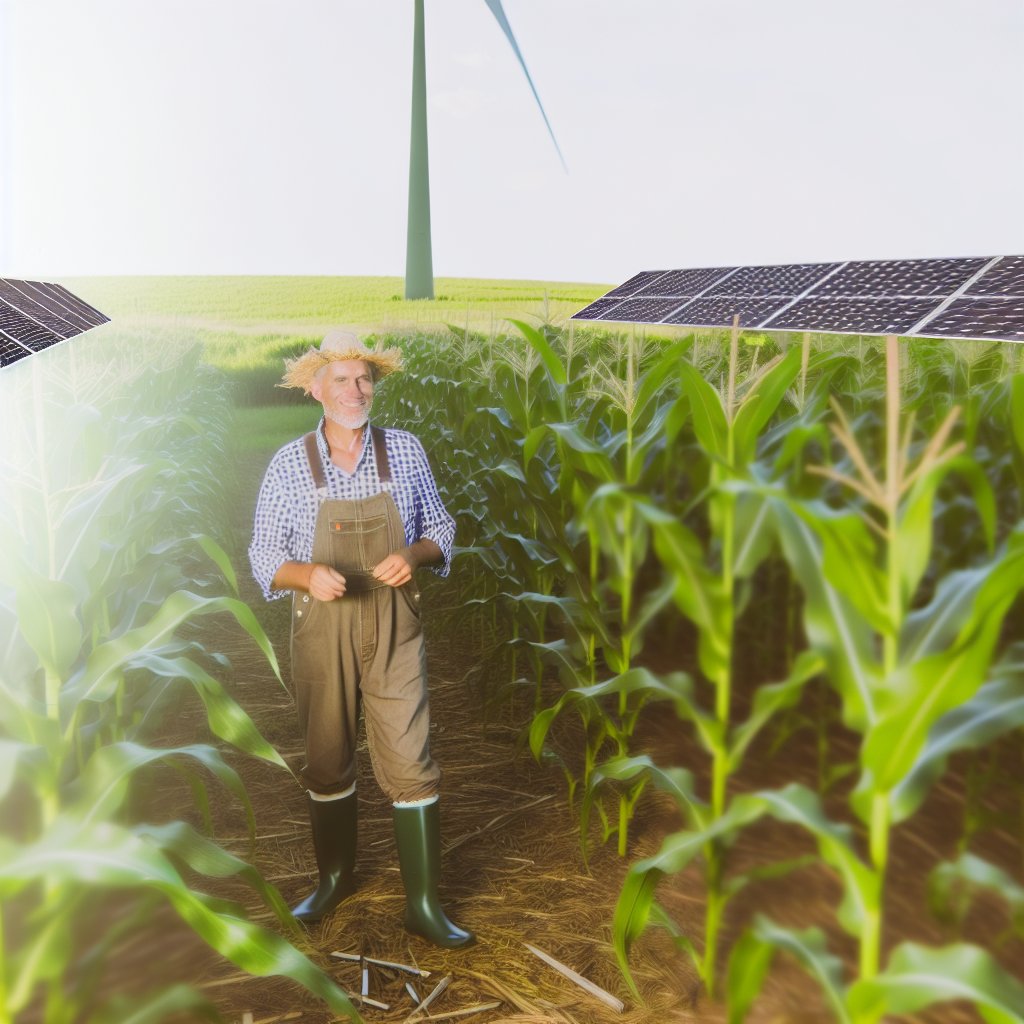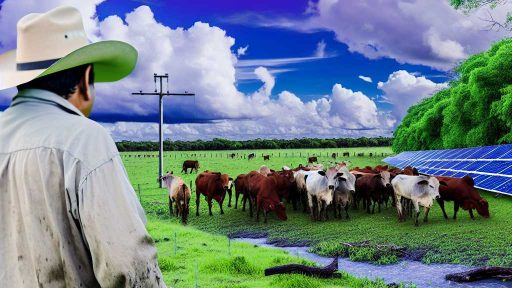Introduction to Renewable Resources in Agriculture
Renewable resources play a crucial role in modern agriculture.
They help farmers reduce reliance on fossil fuels.
Moreover, leveraging these resources promotes sustainability.
Types of Renewable Resources
Farmers can utilize various renewable resources for energy efficiency.
Solar energy, for instance, is increasingly popular.
Wind power also offers significant advantages for agricultural operations.
Additionally, biomass can be converted into biofuels for farming equipment.
Benefits of Renewable Resources in Farming
Incorporating renewable energy sources reduces operational costs.
It also leads to lower greenhouse gas emissions.
Furthermore, using these resources enhances energy security.
By adopting renewables, farmers can promote a healthier ecosystem.
Barriers to Adoption
Despite the benefits, some barriers exist in adopting renewable resources.
Initial costs can be a significant concern for farmers.
Moreover, technical knowledge may be limited in some regions.
Access to financing is another challenge that needs addressing.
Transform Your Agribusiness
Unlock your farm's potential with expert advice tailored to your needs. Get actionable steps that drive real results.
Get StartedFuture Trends in Renewable Agriculture
Looking ahead, the integration of technology will enhance renewable resource usage.
Smart farming techniques will optimize energy consumption.
Additionally, policy support will likely drive adoption rates higher.
Thus, the future of renewable resources in agriculture looks promising.
Types of Renewable Resources for Energy Generation
Solar Energy
Solar energy harnesses sunlight using various technologies.
Photovoltaic panels convert light directly into electricity.
Solar thermal systems capture heat for energy uses.
This resource significantly reduces reliance on fossil fuels.
Moreover, it offers scalable solutions for farms of all sizes.
Wind Energy
Wind energy generates power through the use of turbines.
These turbines transform wind movement into electrical energy.
Wind farms can be installed on land or offshore.
Wind energy demonstrates a low environmental impact.
Additionally, it can complement other renewable sources.
Biomass Energy
Biomass energy relies on organic materials for fuel.
This includes agricultural residues, wood, and waste products.
By converting biomass, farmers can produce electricity or biofuels.
Furthermore, this method aids in managing waste sustainably.
It also contributes to reducing greenhouse gas emissions.
Geothermal Energy
Geothermal energy utilizes heat from beneath the Earth’s surface.
This heat can be used to generate electricity or for heating.
Geothermal systems are highly efficient and reliable.
They require minimal land and have a small carbon footprint.
This energy source is especially effective in volcanic regions.
Showcase Your Farming Business
Publish your professional farming services profile on our blog for a one-time fee of $200 and reach a dedicated audience of farmers and agribusiness owners.
Publish Your ProfileHydropower
Hydropower generates energy from moving water.
Dams or water mills are common structures used for this purpose.
This resource is capable of producing significant amounts of electricity.
Hydropower systems can also provide irrigation for farming.
However, careful management is necessary to protect aquatic ecosystems.
Benefits of Energy-Efficient Farming Practices
Cost Savings
Energy-efficient farming reduces operational costs significantly.
Farmers save money on fuel and energy bills.
These savings can improve the farm’s profit margins.
Environmental Impact
Implementing energy-efficient practices lowers greenhouse gas emissions.
This contributes positively to climate change mitigation.
Moreover, sustainable practices promote soil health and biodiversity.
Enhanced Crop Yields
Using renewable energy sources can lead to improved crop productivity.
Efficient irrigation systems ensure optimal water usage.
Subsequently, healthier plants yield better harvests.
Increased Energy Independence
Energy-efficient farms become less reliant on external energy sources.
This independence adds stability and security to farm operations.
Farmers can innovate without worrying about fluctuating energy costs.
Consumer Appeal
Energy-efficient practices attract environmentally-conscious consumers.
Shoppers are increasingly prioritizing sustainability in their choices.
This awareness can boost a farm’s marketability and sales.
Policy Incentives
Many governments offer incentives for energy-efficient farming.
Grants and tax breaks can support the initial investment.
Importantly, these policies promote sustainable agricultural practices.
Community Benefits
Energy-efficient farming fosters local community resilience.
Sustainable practices enhance local ecosystems and resource preservation.
Additionally, it creates awareness and engagement among community members.
Uncover the Details: Renewable Resource Utilization in Sustainable Pest Control
Solar Energy Utilization in Agricultural Settings
Harnessing Solar Power
Farmers increasingly adopt solar energy to enhance productivity.
This renewable resource provides a sustainable power source for various farming operations.
Moreover, solar panels can supply energy for irrigation systems, significantly reducing operating costs.
Benefits of Solar Energy in Agriculture
Solar energy offers numerous benefits for agricultural practices.
First, it reduces dependency on fossil fuels.
Consequently, this leads to lower greenhouse gas emissions.
Second, solar energy systems can offer significant long-term savings.
By generating their own electricity, farmers decrease utility bills.
Applications of Solar Technology
Various solar technologies serve agricultural needs efficiently.
Solar water pumps ensure reliable irrigation even in remote areas.
Additionally, photovoltaic cells provide energy for greenhouse operations.
These applications help increase crop yields while minimizing labor costs.
Successful Implementations
Many farms have successfully integrated solar energy into their operations.
Showcase Your Farming Business
Publish your professional farming services profile on our blog for a one-time fee of $200 and reach a dedicated audience of farmers and agribusiness owners.
Publish Your ProfileFor instance, Willow Creek Farms installed solar panels to power their irrigation system.
This move resulted in a 30% reduction in energy costs within the first year.
Similarly, Greenfields Organic Farm utilized solar energy for climate control in greenhouses.
Future Prospects of Solar Energy in Agriculture
The future for solar energy in agriculture looks promising.
As technology advances, solar systems become more efficient and affordable.
Farmers will increasingly turn to solar solutions to meet energy demands.
Furthermore, government incentives will encourage sustainable practices.
Gain More Insights: Best Soil Nutrient Management for Long-Term Farm Sustainability
Wind Energy Solutions for Modern Farming
Overview of Wind Energy in Agriculture
Wind energy plays a crucial role in modern farming.
This renewable resource offers sustainable solutions for energy needs.
Farmers increasingly adopt wind turbine systems to generate electricity.
These systems help reduce operational costs and carbon footprints.
Advantages of Wind Energy
Wind energy presents numerous benefits to farmers.
First, it lowers dependency on fossil fuels.
Second, it provides a reliable power source for rural areas.
Additionally, farmers can sell excess energy back to the grid.
This creates potential revenue streams for their operations.
Implementing Wind Turbines
Installing wind turbines requires careful planning.
Farmers must assess their land for wind viability.
Site selection is crucial to maximize energy generation.
Furthermore, farmers should calculate financial feasibility.
Grants and incentives can assist with initial investments.
Case Studies of Successful Applications
Several farms have successfully integrated wind energy solutions.
Greenfield Farms in Nebraska exemplifies this transition.
They installed a wind turbine that powers their irrigation systems.
As a result, they save thousands in energy costs annually.
Another success story is Hillcrest Ranch in Texas.
Their turbines support both farming operations and livestock facilities.
Challenges and Considerations
Despite the many benefits, challenges exist in wind energy adoption.
Initial installation costs can deter some farmers.
Moreover, zoning regulations may limit turbine placement.
Farmers should engage with local authorities early in the process.
Ongoing maintenance is essential for optimal performance.
Future Trends in Wind Energy for Farming
Wind energy technology continues to evolve.
Newer turbine models are more efficient and cost-effective.
Additionally, advancements in energy storage systems enhance reliability.
Future integration with smart farming technologies is promising.
Farmers who embrace wind energy will lead the shift towards sustainability.
Delve into the Subject: Biodiversity Enhances Farm Resilience

Biomass as a Renewable Resource in Crop Production
Defining Biomass
Biomass refers to organic material derived from plants and animals.
Showcase Your Farming Business
Publish your professional farming services profile on our blog for a one-time fee of $200 and reach a dedicated audience of farmers and agribusiness owners.
Publish Your ProfileThis resource is renewable and can be replenished over time.
Common sources include crop residues, manure, and dedicated energy crops.
The Role of Biomass in Agriculture
Biomass enhances soil health and fertility significantly.
It provides essential nutrients to crops and improves soil structure.
This practice also helps in carbon sequestration.
Farmers can utilize biomass for mulching and composting.
Consequently, this promotes a circular economy in farming.
Benefits of Using Biomass
Utilizing biomass reduces reliance on synthetic fertilizers.
This not only cuts costs but also mitigates environmental impacts.
Farmers can generate renewable energy through biomass conversion.
Biomass fuels can power machinery and heating systems.
Moreover, this process can create additional revenue streams.
Implementing Biomass Systems
Farmers should begin by assessing available biomass resources.
Engaging in community efforts can maximize biomass availability.
Collaboration with local agronomists fosters best practices.
Utilizing proper storage techniques is crucial for maintaining quality.
Additionally, regular training and workshops can prove beneficial.
Case Studies of Successful Biomass Utilization
Several farms have transformed their operations using biomass.
Agricultural innovations often showcase increased productivity.
For instance, Greenfield Farms successfully integrated biomass systems.
Their approach reduced operational costs while boosting crop yields.
These success stories serve as valuable models for others.
Learn More: Monitoring and Assessing Pests in IPM Systems
The Role of Geothermal Energy in Sustainable Farming
Introduction to Geothermal Energy
Geothermal energy utilizes heat from the Earth’s core.
This renewable resource provides sustainable energy for farming.
Farmers can adopt geothermal systems to improve efficiency.
Benefits of Geothermal Energy in Agriculture
Geothermal energy offers various advantages for farming practices.
- It reduces reliance on fossil fuels.
- It lowers operational costs significantly.
- This energy source promotes more predictable energy expenses.
Applications of Geothermal Energy in Farming
Farmers use geothermal energy for heating purposes.
Greenhouses can stay warm during cold seasons.
Soil heating fosters better plant growth early in the season.
Additionally, geothermal energy powers irrigation systems.
It ensures crops receive adequate water without wasting resources.
Impact on Crop Production
Incorporating geothermal energy enhances crop yields.
It allows for year-round production regardless of climate challenges.
Furthermore, geothermal systems can improve soil health over time.
Challenges and Considerations
Despite its benefits, geothermal energy has challenges too.
Initial installation costs can be significant.
Farmers must consider the geological suitability of their land.
Moreover, ongoing maintenance is essential for optimal performance.
Future of Geothermal Energy in Farming
The future looks promising for geothermal energy in agriculture.
Showcase Your Farming Business
Publish your professional farming services profile on our blog for a one-time fee of $200 and reach a dedicated audience of farmers and agribusiness owners.
Publish Your ProfileInnovations in technology continue to improve efficiency.
As more farmers adopt this method, sustainable practices will grow.
Transitioning to geothermal energy contributes to a greener planet.
Case Studies: Successful Integration of Renewable Resources in Farming
Solar Energy in Greenhouses
Greenhouse farming often uses solar energy for heating and lighting.
The Verdant Greenhouse Company implements solar panels on their roofs.
This integration reduces their electricity costs significantly.
As a result, they report increased crop yields and affordability.
Wind Power for Irrigation Systems
Wind energy serves as a reliable power source for irrigation.
The Windy Acres Farm harnesses wind turbines to drive their pumps.
This method eliminates dependence on fossil fuels for irrigation.
Consequently, they save on fuel costs and promote sustainability.
Biogas Production from Livestock Waste
Animal waste can produce biogas, which generates electricity.
The EcoFarm employs anaerobic digesters to process waste efficiently.
Through this, they create energy for farm operations and homes.
This innovation also reduces methane emissions, enhancing environmental health.
Hydroponic Systems Powered by Renewable Energy
Hydroponics represents a soil-less farming method that can thrive on renewable resources.
The AquaGrow Facility uses solar and wind energy to power their systems.
This alignment enhances resource efficiency while minimizing water usage.
With this approach, they achieve faster plant growth and higher quality produce.
Community Supported Agriculture (CSA) Initiatives
CSAs engage local communities in sustainable farming practices.
The GreenThumb CSA promotes the use of renewable resources among its members.
They educate farmers about solar irrigation and composting techniques.
As a result, this initiative fosters local food security and environmental stewardship.
Each case study demonstrates the potential for renewable resources in farming.
These innovations not only enhance efficiency but also promote sustainability.
As more farms adopt such practices, they contribute to a greener future.




